Book Reviews
by Max Ink Staff Writers
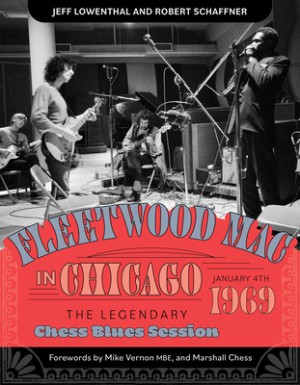
Band photo by Jeff Lowenthal
Fleetwood Mac in Chicago: The Legendary Chess Blues Session - January 4, 1969
Author: Robert Schaffner & Jeff Lowenthal
Review By Bruce Alexander & Michael Sherer
Publisher: Schiffer publishing
Posted: Jan 2023
(2529) Page Views
This is the first book to cover Fleetwood Mac in their early stages, and it’s all from the legendary Chess Studios in Chicago.
These recording sessions took place in January 1969, when Fleetwood Mac were a British blues band. Founded in 1967 in London, England by Peter Green, Jeremy Spencer and Mick Fleetwood, it then consisted of Green (guitar, vocals), Spencer (guitar, vocals), Fleetwood (drums), John McVie (bass guitar) and Danny Kirwan (guitar, vocals).
The Chicago blues musicians who also played at this session were Willie Dixon (vocals and guitar), Otis Spann (piano, vocals), (upright bass), Shakey Horton (harmonica, vocals), J.T. Brown (tenor saxophone, vocals), Buddy Guy (guitar) Honeyboy Edwards (guitar, vocals), and S.P. Leary (drums).
Jeff Lowenthal was the only photographer at the sessions, and his work is candid, insightful and very fine, as is the book as a whole. There are many more black and white photos than there are color.
Also featured are forwards by session producers Marshall Chess and Mike Vernon, texts by Robert Schaffner and some of the participating musicians. Additionally, there’s commentary by non participating musicians such as drummer Aynsley Dunbar, the late Kim Simmons of Savoy Brown, Martin Barre of Jethro Tull and Rick Nielsen of Cheap Trick. There’s also a new interview with Buddy Guy.
In essence, this book captures a hungry, still rather new English blues band that were six years away from breaking it big with a different lineup and sound in ‘75 that by then had seen the loss of Green, Spencer and Kirwan.
However, back at the start of ‘69 they were taking their original blues ethos with much seriousness and finding their way. It was a very different era and ethos for them than what was to come, and if one cares to dig deep into their entire history, this book is a must to view their first wave.
Author Robert Schaffner & Jeff Lowenthal Online
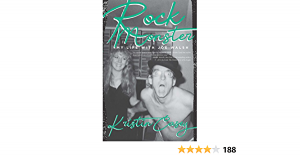
KRISTIN CASEY ROCK MONSTER: MY LIFE WITH JOE WALSH
ROCK MONSTER: MY LIFE WITH JOE WALSH
Author: Kristin Casey
Review By Tommy Rage
Publisher: Rare Bird Books
Posted: Feb 2021
(5483) Page Views
Life’s been good to me so far, and that’s just not a great Joe Walsh song. Life’s been pretty good for one of rock’s greatest guitarist, but that wasn’t always the case for Joe Walsh. He is famous for of his legendary skills as a guitarist, song-writer and singer, but infamous because of his well-documented rock escapades. From his notorious hotel room destruction with a chainsaw to his pound a day cocaine habit, Walsh has lived a hedonistic life-style. Perhaps though, Walsh’s creativity was fueled by his outrageous cocaine and vodka habit as well as his rock star adventures. His numerous radio hits ranging from the James Gang’s “Funk #49” to the Eagles “Life In The Fast Lane” showcased Walsh’s talent with millions of records sold over a 50 year career.
Known the world over for his solo works, such as “Rocky Mountain Way” and “All Night Long”, Walsh continued his wild-man ways into the 80’s when he was introduced to a young stripper by the name of Kristin Casey. Having met through a mutual friend, Kristin Casey shares how she and Walsh began a torrid and wild six year relationship. “I met Joe in 1988, it was probably the tail end of it. I was 20 years old and stripping for a living with my friend, Vicky, in Austin, Texas. She happened to be dating Joe’s bass player at the time. I think she probably told me the name of the band he was in, and maybe Joe’s name, but I’d never heard the name before. I had been stripping since I was 18, and I was into the whole punk scene. One night Vicky asked me for a ride to a hotel to see her boyfriend who was in town with Joe. It was about 2:30 in the morning and she said I should come up [to the room] and meet Joe. She said that he was recently single, and that we might like each other. I figured I’d probably get bored in 15 minutes and then just go home. But he was a musician and an older man, and I liked older men, so I thought, “who knows.” When we got to the hotel room, he and I hung out all night and really hit it off, it was a big spark. He put me and my friend on the guest list for his show the next night. We went to the show and that’s when I heard him play his songs and I recognized song after song. It was then that I realized I had spent the night with a rock star and how huge he was. I had heard him on the radio, but the way we met was really organic.”
Coming on the tails of one of Joe’s least successful albums “Got Any Gum”, which came out in 1987, Casey opened herself to new world of sex, drugs and rock & roll. Keeping a journal and sharing the intimate details about their love affair in her book, “Rock Monster: My Life With Joe Walsh”, Casey shares how both guarded and vulnerable Walsh was. From his kinky sex fetishes of bondage, masks, sex toys, and how he asked her to pleasure both himself and a stranger they met while on a flight to Japan; Casey shares how the emotional rollercoaster lead her down a dark path. “Joe is one of the most unique individuals I’ve ever met. Not many people know him for who he really is. I think he is very guarded. I still see it in his interviews. He’s not fake. He will make a lot of jokes and deflect attention away from anything too personal, he was always known as the ‘Clown Prince of Rock’. At the same time, he is sensitive to all the pressures to be successful. I think that sometimes he was overwhelmed by his fame and by the adoration of his fans, and not in a bad way. He just felt pressure from Don [Henley] and Glen [Frey] to always do his best. It was very important for him to live up to that, to live up to his potential and to live up to their expectations because he valued them so much. So, I think that that made him, at times, a little stressed, especially in the years that I was with him because he wasn’t as commercially acclaimed as he was before. At the time, I had worked in a bar and I was 20 years old, but I didn’t drink all the time. Once I got together with him, my drinking was really unchecked. We were definitely partners in crime in that respect. Joe had been, what you would call a functional addict. He was a high-functioning addict. It happened before I met him. To be able to put out all this amazing music, and maybe that lifestyle was actually sort of required in his line of work. But you can’t do that for long. In the beginning, it was a lot of fun, and it was terribly unhealthy. But it got to the point where it really wasn’t fun anymore, where we were fighting all the time because we didn’t communicate, we had no coping skills, and we were at the bottom. He could have become a footnote in rock history where people say, ‘That poor guy, he used to be so great.’ Nobody out there that has binged on coke is ever gonna say it wasn’t fun, but I was close to death at times.”
Casey takes detailed time in her 300 plus pages of “Rock Monster: My Life With Joe Walsh”, to paint pictures of wild nights, revealing exploits, and the difficult steps to recovery. With an almost guilty-like peek into the life of someone who is lost, yet begs to be loved and desired; Casey shares the alluring side of self-destruction with rock & roll. She recalls how present when Walsh received the phone call about getting back together with the Eagles for their famous 1994 reunion album and tour “Hell Freezes Over”. Walsh was required to be clean and sober, as the other band members were. Walsh entered rehab and has successfully stayed true to his sobriety ever since. Casey on the other hand, was left alone in L.A. “I was drinking a ridiculous amount. I pushed everyone away from me. I realized that I had spent so many years investing my entire identity into Joe and his life, his world, and myself as his girlfriend and fiancée that I had lost any real sense of identity as who I was as an individual. I didn’t feel like I had any substance, there was nothing to me, I was invisible without him, and I decided to kill myself.”
Diving deep into her personal struggles to find sobriety, Casey gives hope to those who have battled substance abuse. Sharing never-seen-before photos of her and Walsh, Casey provides hope to those struggling with addiction. The current blogger, intimacy coach and writer can look back fondly to her wild days, and laugh about one encounter that still makes her smile. “We were living together in Studio City, California, when Joe said that Stevie Nicks invited him over for dinner. He said that he had told her about me and Stevie said that I had to come, too. I thought that was the classist thing in the world to do. I was nervous about meeting her, but Joe said that she was probably more nervous about meeting me. Maybe he was right, because she was still in love with Joe. I didn’t even know that they used to date. So we get to dinner that night and she really was nervous and so was I [laughter]. She could not have been sweeter to me, she was absolutely lovely. We had a lovely dinner, and she had this pendant in her hair that she couldn’t get out. I helped her with it and she gave it to me as a gift. After dinner we all went back to our house, and a bunch of Joe’s friends show up. As the night went on, us girls were sitting on the floor and she was talking more and more and just started taking off all her jewelry. She was just putting it in a pile on the floor, and it was pretty substantial, but she was leaving it all over the place. Meanwhile she was rambling and making less sense, that’s when she goes upstairs and just starts playing the piano [laughter]. It just goes on-and-on, when Joe pulls me aside and says that he keeps dropping hints, but she won’t leave. I said that I could handle it. I sat down and just very politely thanked her for coming over, and that it was great meeting her and telling her that Joe and I were going to bed now because it was late. I was hoping she would get the hint, but she didn’t get up to leave, she just said that it was wonderful to meet me and kept playing the piano. She was clueless about us wanting her to leave, she was the guest that just wouldn’t leave. Finally someone goes and gets her limo driver. Joe tricks her into going outside, as she was pretty loopy at that time. Her limo driver grabs her and puts her in the limo and he drives off finally at like 4:30 in the morning. The next day she calls and says she lost all her jewelry [laughter]. I tore apart the house looking for her jewelry for two days when finally Stevie calls back and says she found her jewelry. One of her staff had found it all in her purse and had put it in her safe. I say this with all the love in the world- she in one of most amazing women on the planet and I love her.”
Author Kristin Casey Online
• Website • Facebook

Right Place, Right Time - The Life Of A Rock & Roll Photographer
Author: Bob Gruen
Review By Michael Sherer
Publisher: Abrams
Posted: Oct 2020
(3048) Page Views
Bob Gruen has written an insightful, thoughtful and very engaging autobiography that covers the arc of his whole life. Gruen, who turned 75 on October 23rd, goes back to his childhood, having grown up in Great Neck, Long Island, New York. That changed in 1965 via a connection with a local friend, whereby nineteen year old Gruen was able to move into a shared apartment in the spot he longed to be: Greenwich Village, Manhattan.
Approximately 25 miles away from Great Neck and the homogenous, insulated, suburban life that Gruen had experienced, Manhattan is a world apart. Greenwich Village, which has become known as the West Village, along with the East Village across from it, is the most progressive, youth driven and arty area in all of New York and the country at large. Being the home of New York University and Washington Square Park, the latter of which Gruen frequented often, they were and remain major contributors to this exciting and avant-garde culture that Gruen took to immediately.
That time and place of Gruen’s arrival, smack in the middle of the tumultuous and polarized 1960’s, was in the throes of the hippie movement that revolved around Gruen’s generation. Gruen himself identified with its ethos and especially the emphasis on freedom, which he was just now able to relish in.
The Village was the epicenter of it all, (along with the Haight-Ashbury neighborhood of San Francisco at the time) with its folk and jazz music clubs, outdoor coffee and meeting places, resident poets and poetry readings and an overall communial and like minded atmosphere. Many of its streets are narrow, winding and cobblestone, giving it a charm and quaintness that’s reminiscent of European cities like Paris.
It was at George Wein’s Newport Folk Festival in Rhode Island, July 22nd through the 25th, 1965 that Gruen’s love of music, especially folk at that time, and photography were merged. He managed to talk his way in as press, (it wasn’t easy) and emerged with many photos, most notably of literal folk hero and fellow West Village resident Bob Dylan, who made this festival the day that he first publicly held a black electric Fender Stratocaster guitar to replace his acoustic, and became an electric rock/folk artist. It was a big deal in the music scene, and sent the old guard folk purists, such as fellow present performer Pete Seeger into a tizzy. (Seeger reportedly threatened to chop Dylan’s guitar cable with an axe to silence it.)
The rest of Gruen’s book is about all the essential musicians/bands and notable experiences that he had, particularly with, in chronological order: Ike & Tina Turner, John Lennon & Yoko Ono, The New York Dolls, KISS, Deborah Harry and The Clash, although there were so many more. In the case of Lennon and Ono, it began in great part with them living around the corner from Gruen in the West Village, where Gruen remains in the same artists’ building that he was fortunate enough to be accepted for the year it was finished being converted from a Bell Telephone laboratories facility into a residential building, that being 1970.
50 years on from that milestone in Gruen’s life where he had a stable home and solace in the neighborhood that fit him so well, the book delves back into both his interesting personal relationships and professional work through the present, how they often intertwined, and the ways they have brought him far and wide throughout the world. There are lots of insightful photos throughout its pages to illuminate this, from Gruen’s own photos and others having taken pictures of him with his subjects.
The fine Abrams has published the book with robust paper stock and attention to detail, as they have for previous work from Gruen. They can be found at: https://www.abramsbooks.com/
With that, I don’t want to give any more away of this unique and colorful life story. Get a copy for yourself, and enjoy the full, wide angle view.
Author Bob Gruen Online
• Website • Facebook
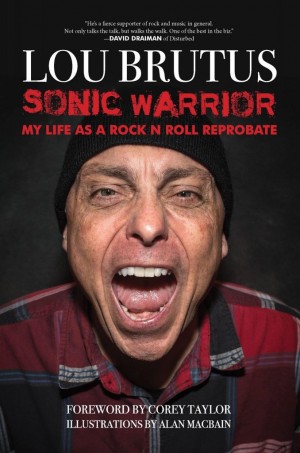
Lou Brutus Sonic Warrior: My Life as a Rock N Roll Reprobate: Tales of Sex, Drugs, and Vomiting at Inopportune Moments
Lou Brutus Sonic Warrior: My Life as a Rock N Roll Reprobate: Tales of Sex, Drugs, and Vomiting at Inopportune Moments
Author: Lou Brutus
Review By Tommy Rage
Publisher: Rare Bird Books
Posted: Oct 2020
(2097) Page Views
John Steinbeck, Ernest Hemingway, Harper Lee, Lou Brutus…Yes, Lou Brutus. Who would have thought that a radio disc jockey would ever be considered a comparable for literature greats? Perhaps this may have something to do with Lou’s 25 plus years as one of the nations most recognized DJs, or perhaps it’s because Lou has lived life as a true reprobate. Sonic Warrior – My Life As A Rock N Roll Reprobate, Lou’s firsthand accounts of his life as a long time music enthusiast as well as a national syndicated disc jockey; is just a brief glimpse behind the life and times of what it means to be a radio disc jockey.
With a collection of short stories, some dating back to Lou’s teenage years where he attended a concert with his older sister and vomited all over her bewildered boyfriend, to the time a famous rock n’ roll dog urinated on him, Lou captures the essence of what rock music fans love. Each of Lou’s 21 biographical stories are just a glimpse into what meeting a rock star like Stevie Nicks would be like, or getting so stoned with Snoop Dogg that you drool on your own lap. Compiling the catalog of catastrophes in brief and easy to read short stories was something that Lou didn’t have to put much thought into. When asked how he went about penning his memoir, Lou shares his thought process. “All of these stories, are stories that I’ve been telling my friends in the rock n’ roll world, some of them for decades. Some of them, I think, have become perhaps slightly infamous, and I’ve told them so many times that writing them came fairly easy. One of the things that I strived for, and from the feedback I’ve gotten, I think I did O.K. on, was people read it, and they say, ‘Oh my God, I hear your voice in my head, that’s exactly how I would imagine you’re telling me the story’. I do add the facts, and figures, dates, and other background things, but for the most part, when I describe the action and the conversations it’s like I would tell the story.”
These first person narratives are insightful to both the music industry and to the pearls of being the professional music fan that Lou is. Cutting his teeth and refining his DJ skills with notable radio stations such as WPLJ (New York), WBCN (Boston), and WRCX (Chicago), Lou got to meet some of rock’s biggest icons. Now, as Senior Director of Music Programing at Sirius XM and host of his syndicated radio show, hardDrive with Lou Brutus & hardDrive XL, Lou can look back fondly at the time he threw up over 10,000 concert goers at the Live Aid concert back in 1985. These ‘once-in-a-lifetime’ stories of having your life energy drained out of your body through the palm of your hand by Keith Richards, or being peed on by a famous rock n’ roll dog are glimpses at the insanity of the music industry. If you pay close attention to the way Lou writes about the time he was accosted by legendary author Hunter S. Thompson, who we writes about in a Thompson-esque way, you know that Lou sought to share folklore fables and not badmouth any of the musicians. “There’s really nothing in their that’s terrible about anybody else. If anybody looks bad at any point in the book, it’s me [laughter]. Early on in the process, I made a decision that I didn’t wanna put out a book that was going to dump on other people or make other people look bad. I’ve certainly been around enough things, and I’ve seen a lot. So, if I wanted to put it in a book, and make it more scandalous - it would have been easy to do. But I didn’t wanna be an asshole and I didn’t wanna write that kind of book. I knew that I had enough things already that were funny and crazy and unlikely, and the ‘Oh My God, I can’t believe that happened.’ So, I could write these stories and not have to trash another human being, and that’s the path I chose.”
From the inside scoop on Gene Simmons’ bowling game, to the sights and sounds of what actually goes on backstage at concerts, Lou reminds us that sometimes dealing with rock stars (and the Wisconsin State Troopers), is simply a comedy of errors. Each story flows from begging to end, each one taking you along with Lou on the adventures which were often not planned, but simple happenings of being the legendary DJ that he is. With his easy of writing and focus directed on the experiences of each band, the reader harkens back to the days of saving concert ticket stubs, buying bootleg concert shirts, and the morning-after concert ringing in their ears.
Releasing an audio version of his book read by himself in his well-known radio voice, coupled with the books clever caricature illustrations by Alan MacBain, Lou leaves us wanting more. “There was a whole lot that I did not put in the book that I could have put in; including probably at least two or three chapters that I really should have put in. I can give you some chapters of the second book, titles that would include: ‘The time 150,000 Dead Heads dropped acid right outside of my lonely teenage bedroom’, ‘The time I danced on Hitler’s grave with Pink Floyd’, ‘The time an incredibly talented 300 pound schizophrenic street singer recorded and released a song about me’, or ‘The time I turned down a private lunch with Pope John Paul II to spend time with Ozzy Osbourne’ [laughter]. But that will give you an idea of some of the stuff that would come in a second book.”
Fans who may not be familiar with Lou’s radio career will still appreciate the intriguing encounters Lou has had. By sharing these ventures with fans from all generations of rock. Whether it be the time Robert Plant charmed the shit out of Lou’s date, or swatting at a giant duct-tape penis on stage at a Slipknot concert, on thing is for sure: Lou Brutus is a true rock n’ roll reprobate. And even if he doesn’t win a Pulitzer Prize, rumor has it that Ernest Hemingway was also a huge Slipknot fan, so at least they have that in common.
Author Lou Brutus Online
• Website • Facebook
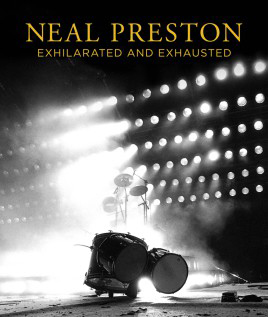
Neal Preston: Exhilarated and Exhausted
Neal Preston: Exhilarated and Exhausted
Author: Neal Preston
Review By Michael Sherer
Publisher: Reel Art Press
Posted: Nov 2017
(7294) Page Views
“I want the reader at the end of this book to feel like they’ve just spent a year on the road with Zeppelin with one day off, then six months with Guns ‘n’ Roses, with one day off and then five years with Bruce Springsteen. Exhilarated and exhausted.” - Neal Preston
Neal Preston is one of the most published, known and respected music based photographers of modern times. He was busiest as a young man with the stamina to be working almost constantly during rock’s golden age: The 1970’s.
This excellent and finely crafted book from Reel Art Press is a retrospective of Preston’s entire career. With a foreword by Neal’s best friend, esteemed screenwriter and film director Cameron Crowe, and an introduction by Preston, the elusive mood, ethos and depth of Preston’s work is set from its start.
The book represents the first time that Preston has allowed full access to his vast archive, stretching back fifty years. 335 large pages of this robust collection still doesn’t cover all of the dozens of artists that Preston has photographed, often intimately. In addition to the performance images, portraits, backstage scenes, outtakes and personal moments that only someone with this kind of access could attain, thoughtful and insightful running commentary by Preston accompanies the striking images. This is a window into understanding the man behind the camera, and Preston clearly put a lot of time and effort into his choice of words.
Anyone that truly understands photography knows that access and how to use it is absolutely key, and Preston was in the driver’s seat as he was the official tour photographer for many bands and artists, thereby allowing him coveted and complete access. Led Zeppelin, Queen, The Who, Bruce Springsteen and Guns ‘n’ Roses are some of the employers of Preston as their official lensman as they toured extensively. Zeppelin is the band most closely associated with Preston, and they were, of course, one of the very biggest and charismatic groups of their time. They were also the least media friendly, wanting to maintain a certain mystique. However, they and their highly intimidating and protective manager, Peter Grant, (a huge man that had been a wrestler amongst other occupations) welcomed Preston in with open arms.
Preston, 65, was just the right age (as were the artists themselves) to have the maturity, natural talent and instincts, but also and very importantly the great drive and strength of youth to take on the highly demanding grind that these tours posed. The books’ title obviously reflects the thrill of capturing the images of an ambitious insider, yet at the cost of comprehensive exhaustion.
Preston says “Shooting live music performances is something few photographers do really well. I just happened to discover one day that I was pretty good at it.” Indeed he is, and Preston’s images are the visual fodder of rock and roll’s most glorious times. In my view we’ll never see such an exciting and inspired confluence of forces again in real life, but within these pages we’ll never not. Grab it.
Author Neal Preston Online
• Website

All photography by Lynn Goldsmith
KISS - 1977-1980, Photography by Lynn Goldsmith
Author: Lynn Goldsmith
Review By Michael Sherer
Publisher: Rizzoli
Posted: Oct 2017
(7371) Page Views
Celebrated and veteran photographer Lynn Goldsmith, in conjunction with top shelf (no pun intended) book publisher Rizzoli, has compiled and released an excellent presentation of the band KISS during their height of popularity, that being 1977 through 1980. With access and trust being key for successful photography, (in addition to the obvious talent, creativity and eye) Goldsmith had that access in spades with the band. While incorporating her own compelling ideas and gifts in her craft, Goldsmith was able to capture stellar images of this highly theatrical and visual group of four distinct personas that comprise KISS. This includes many candid, behind the scenes photos, and a nice mix of color and black and white.
Additionally, Goldsmith worked with founders Gene Simmons and Paul Stanley in having them provide current written commentary throughout the book. They had a very good rapport, being about the same age and sharing Jewish roots. An added plus is that although KISS is from New York City, they first broke in Detroit, a city that truly loves their rock and roll. Goldsmith is from that city and can relate to it all. Relating to a photographer’s subject is important, as it not only allows for an effective exchange but also interesting ideas, which Goldsmith has many, especially with KISS.
This large sized, silver colored book of a few hundred pages is an essential addition to any KISS fan and/or of rock and roll based photography. Highly recommended!
Author Lynn Goldsmith Online
• Website • Facebook
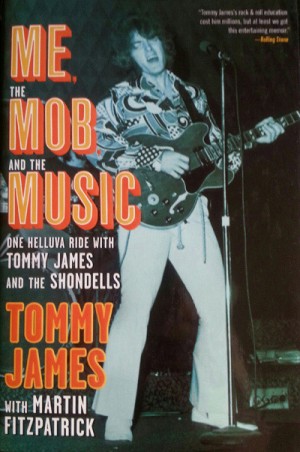
Tommy James
Me, The Mob, And The Music - By Tommy James with Martin Fitzpatrick
Author: Tommy James with Martin Fitzpatrick
Review By Michael Sherer
Publisher: Scribner
Posted: Jul 2016
(6647) Page Views
This compelling book tells the story of how Thomas Jackson, later to be renamed Tommy James, played locally in Niles, Michigan for years until a cover of an obscure song called Hanky Panky in ‘64 was cut. One of a few songs he and his group recorded in a local studio, it was to have huge consequences when two years later a radio DJ in Pittsburgh discovered it and began playing it very frequently. It received a rousing response from listeners and Tommy had a big regional hit on his hands. Things snowballed from there, with Tommy taking on a manager who negotiated with several record company executives that were quite interested in signing Tommy and the band. While Tommy went overnight from languishing in small town Michigan to being able to mull over these tantalizing offers from several NYC record company honchos, he was suddenly informed that all of them but one was still interested, that being the infamous Morris Levy and his Roulette Records. It turns out that Levy was a ruthless and feared figure in the industry and had made it clear to all the other executives that Tommy was HIS artist and they had to back off. Not wanting to deal with Levy’s wrath, they did.
Referred to as “The Godfather” of the record business, Levy had been toiling in it since the mid ‘50’s after becoming the owner of the most known of all the jazz nightclubs, Birdland, NYC. (Named after saxophonist Charlie Parker’s nickname.) Along the way he established close ties to the Genovese crime family and other mob figures, earning him this dubious title. Levy’s Roulette hadn’t had a hit for some time, and he wasn’t going to let this one pass him by. It was still the era of hit singles, although that was soon to change.
Full LP record hits began to take over in ‘68, the same year that FM radio surpassed AM. That’s not a coincidence, as it was FM that was playing much longer songs and even full record sides while AM stuck to the top 40, short single format. FM also sounded far better than the mono AM. In addition it had come time for artists to either write their own material or be considered hokey and passe. The Beatles were a big catalyst for this change. Publishing rights and royalties from these original songs is where Levy made a fortune, whereby he hardly payed the artists (or didn’t pay at all) and acquired the publishing of many other labels from their bosses, namely of George Goldner in card games where Goldner needed to sell to pay his gambling debts.
A running and pathetic joke in the industry was that the office of the man that paid royalties to Roulette’s artists was the quietest place in the world because nothing was happening. It all had to be signed off by Levy, and he wouldn’t do much of anything with that. He was known to crack “You want royalties? Go to England.” Tommy and his group was a case of an artist being able to cater fully to both the past singles world and the new one described here, coming on the scene in a very interesting and transitional period.
The book’s central theme is the highly complex, multi faceted relationship between Tommy and Levy. Tommy and his group The Shondells was Roulette’s biggest money maker with many hits coming in, such as “I Think We’re Alone Now,” “Crimson And Clover,” “Money Money” and “Crystal Blue Persuasion.” But as noted, Levy wasn’t paying Tommy, let alone the band, their due royalties. He would stall and make excuses, often that studio costs had to be recouped, which in reality had already happened. Instead Levy would occasionally have his secretary Karin write Tommy a check for typically ten thousand dollars. This was only a tiny fraction of what he was owed, though. For years and years Tommy’s great frustration with not being paid weighed very heavily on him, but at the same time Levy became like a mentor and father figure to him, as well as giving Tommy total creative freedom with his records and providing an exciting and educational atmosphere at the offices where the eager student of the business spent much time. And then there were the industry parties.
Greatly in part from Tommy’s frustrations with Levy, he had personal struggles for many years. He did overcome them, however. Along the way Tommy toured the world and had a hell of an adventure. It’s all documented in this book. Also included are photos of Tommy through the decades. Now 50 years on since Hanky Panky jump started Tommy’s entire career, it’s a good time to read how it all unfolded. I highly recommend this book with it all told from the man himself.
Author Tommy James with Martin Fitzpatrick Online
• Website • Facebook
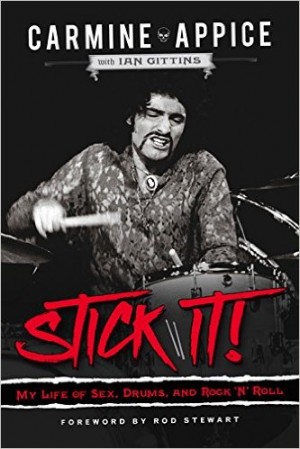
Carmine Appice
Stick It! - My Life of Sex, Drums, And Rock ‘N’ Roll, by Carmine Appice with Ian Gittins
Author: Carmine Appice
Review By Michael Sherer
Publisher: Chicago Review Press
Posted: Jul 2016
(7779) Page Views
This page turning book, written by Carmine with the help of Ian Gittins, tells of the amazing, fifty year plus year journey of one of the most influential, innovative and well known rock drummers of all, and one who has seen and done everything that someone could dream of in living a proverbial rock star life.
Growing up in Borough Park, Brooklyn, a very Jewish and Italian area of NYC, Carmine hung with gangs as a teenager and indulged in some of their hoodlum activities. At least a couple of the other guys wound up going to jail or dying from overdosing. Or were snuffed out from Mafia related reasons upon getting involved with organized crime. Carmine decided that he wasn’t going to go in that doomed direction, and was determined to make it in music instead. After toiling in some other groups trying to make it he joined The Pigeons, another local band, after being highly impressed with their musicianship. They changed their name to the much more interesting Vanilla Fudge when a female fan said after a concert that they sounded like a white soul band, like vanilla fudge. They also found an effective manager in Phil Basile, in good part because he was connected to the mob and owned a big and popular club in Long Island to have them be the house band for.
Fame hit in ‘67 when the band scored a spot on the hugely coveted Ed Sullivan show to perform their slowed down, heavy and organ soaked hit cover of The Supremes’ You Keep Me Hangin’ On. With Sullivan’s variety show breaking open careers, and with the show having a staggering and unheard of 73 million viewers glued to their televisions for the appearance of The Beatles three years earlier in ‘64, this moment would be Carmine’s high water mark, and all at the age of 21. And luckily it happened when it did as Sullivan’s show was cancelled in ‘71 by CBS after a 23 year run when its ratings had dipped significantly.
Carmine discusses a range of interesting tales, such as spending time with Jimi James in The Village in NYC as they were both gigging. James would go on to become a sensation in London and then the world as Jimi Hendrix. Among many other things, we learn of perpetual trashing of hotel rooms, having newly formed Led Zeppelin open for the Fudge on Zep’s first American tour in ‘68, indulging in approximately 4,500 groupies, being in band with Jeff Beck (and how mercurial he is) and sexual tag team buddy/bassist Tim Bogert as BBA in the early ‘70’s, playing with mega star and former Jeff Beck Group singer Rod Stewart for several years and touring the world first class with him, touring with Ozzy Osbourne and then being fired by Ozzy’s wife and manager Sharon when she felt he was grabbing too much attention as a big name, getting married five times, and finally finding his soul mate in the 2000’s, radio personality Leslie Gold, with whom Carmine is still happily with. While Carmine, now 69, has settled down, this book looks all the way back and lets it all hang out. Plus there are great photos in it, with one taken by me. Go get it.
Author Carmine Appice Online
• Website • Facebook
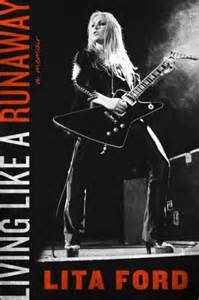
Lita Ford's Autobiography "Living Like A Runaway: A Memoir"
Living Like A Runaway: A Memoir
Author: Lita Ford
Review By Laura Sorensen
Publisher: HarperCollins Publishers
Posted: May 2016
(6223) Page Views
It was impossible for Lita Ford to know how the name of her first band would become part of such an appropriate title for her autobiography 40 years later. At the age of sixteen she became the guitarist for the groundbreaking all female teenage rock band “The Runaways.” Lita blazed a trail for women in rock especially with her amazing guitar playing ability. No one was ready to believe that a female, much less a teenager, could shred the guitar like she could. In her book Lita reveals the trials and tribulations of being part of The Runaways, from management issues to band member conflicts to hardly getting paid for any of it. Her story takes us all the way up to 2015 as she continues to rebound from a fifteen year hiatus and a troubled, painful marriage. Her story is one of hope and inspiration, fear and failure, defeat and conquest. Most of all, it is written from her heart as we get a close look at the inside world of rock and roll from a woman’s point of view.
Love it or hate it Lita Ford connected with a lot of famous rock stars. Some are presented as nice guys, others not so much. It can be a rude awakening to read about people that you thought you admired only to realize they might not be the kind of idol that you really want to follow and model yourself after.
Lita tells it straight from the heart, even when it doesn’t reflect well on her. She is not just a talented musician, she’s an icon, a queen, “The Queen of Heavy Metal” as some have said. I highly recommend this book to anyone who thinks they aren’t good enough, don’t have what it takes, or get their feelings hurt by rejection. If you believe enough in yourself, no one can stop you. Lita is living proof.
Performing: Bratfest, Madison, WI, May 27, 2016
Author Lita Ford Online
• Website • Facebook
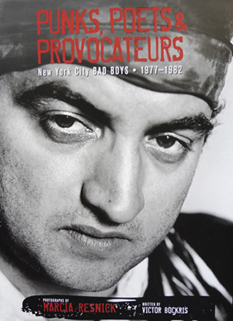
Punks, Poets & Provocateurs: NYC Bad Boys, 1977 - 1982 by Marcia Resnick and Victor Bockris
Punks, Poets & Provocateurs: NYC Bad Boys, 1977 - 1982
Author: Marcia Resnick and Victor Bockris
Review By Michael Sherer
Publisher: Insight Editions
Posted: Feb 2016
(6360) Page Views
In 1977, Marcia Resnick, then 26, began photographing the downtown Manhattan cultural scene. Downtown was “where it was at” for a convergence of rock and roll, jazz, film, literature and art that in retrospect stands as as the counterculture’s last hurrah. And what a hurrah it was. Resnick reflects back on this era by musing “The people from the extraordinary New York milieu amongst whom I was living and working had no way of knowing that the years between 1977 and 1982 were enchanted, endangered, and unrepeatable.” It’s these years that the book covers.
Text by writer Victor Bockris provides much thoughtful insight. There’s also antidotes and accounts from Resnick herself that accompany the images throughout.
This fine, 270 page book focuses mainly on maverick men, i.e., bad boys. Resnick defines a bad boy as those that, as she puts it “Have a special magic, who has charisma, and who braves living on the edge.” Some of the figures that comprise this aesthetic here are the defining beat poets William S. Burroughs, Allen Ginsberg and Gregory Corso, rock and rollers Mick Jagger, Iggy Pop, Johnny Thunders, David Byrne, Joey Ramone and Brian Eno. Under the the provocateurs and raconteurs categories there’s such people as Norman Mailer, Steve Rubell, John Waters, Lester Bangs, Gary Indiana, Andy Warhol, Abbie Hoffman, and the unforgettable man on the cover, John Belushi. There are many more people in all of these spheres, but here’s a taste.
The publisher, Insight Editions, specializes in high quality cultural works that most often include photography and music. Based in San Rafael, CA. They can be viewed at insighteditions.com
Author Marcia Resnick and Victor Bockris Online
• Website • Facebook
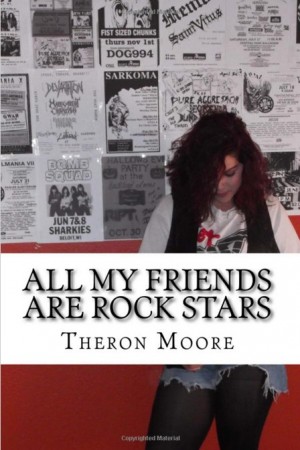
All My Friends Are Rock Stars
All My Friends Are Rock Stars
Author: Theron Moore
Review By Jeff Muendel
Publisher: Mean Machine Press
Posted: Dec 2015
(6208) Page Views
The focus of All My Friends Are Rock Stars is the local rock’n’roll scene during the late eighties and early nineties in the geographical triangle of Rockford, Illinois; Madison, Wisconsin; and Milwaukee, Wisconsin. While that is a fairly narrow spotlight, for those who were involved in those scenes, it makes for an interesting review of the bands, clubs and underground publications of that era. For the wider audience, there are also early stories of bands that made it out of the local scenes to achieve some level of national or international recognition.
Essentially a collection of interviews that often intertwine, Theron Moore has put together a book that could be defined as an oral history of the described upper Midwest rock scene. There are many interesting, funny, and sometimes tragic stories presented about those who toiled for their art in relative anonymity, but the most interesting tend to be about those who clawed their way up to the next level. Interviews include Bun E. Carlos of Cheap Trick, Bill Feeny of The Appliance S.F.B., Dan Hobson of Killdozer, Bucky Pope of The Tar Babies, and Paul Schluter of Last Crack. It’s both fun and cathartic to witness the way in which these groups grew and broadened.
Moore has been freelance writing since 1989, publishing articles and poetry in multiple Midwestern music magazines and websites. In 2011, he edited and self-published his first book, Gangsters, Harlots and Thieves: Down and out at the Hotel Clifton. The author has more books planned for the coming years. All My Friends Are Rock Stars is available on Amazon.com.
Author Theron Moore Online
• Facebook
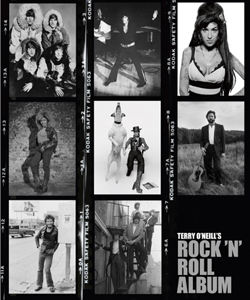
Terry O'Neill's Rock & Roll Album
Terry O’Neill’s Rock ‘N’ Roll Album
Author: Terry O'Neill
Review By Michael Sherer
Publisher: ACC Editions
Posted: Apr 2015
(8264) Page Views
Terry O’Neill is one of the world’s most respected and collected photographers. His widely recognized work can be found in permanent installments of prominent art galleries and private collections throughout the world, and is exhibited in over 30 cities.
Some background: Born in 1938 to Irish immigrant parents, O’Neill grew up in the East End of London. His initial ambition was to be a jazz drummer. He played at United States Air Force bases and jazz clubs throughout and around London, eking out a meager living. He then applied for a job as an air steward with the British Overseas Airways Corporation (BOAC; later to be renamed British Airways). He had hoped to use his off-duty spells in New York City to play in clubs. However, BOAC offered him a position in their technical photography department. O’Neill accepted. This would lead him into the photography world that changed his life.
“I stumbled into photography,” he says about the incidental foray. “I still used to take the whole drum kit - bass, snare, cymbals, everything - all on the bus to Uxbridge, where [my band had a regular contract to perform]. It was the No222 bus. I will never forget that bloody number.”
When asked if he would have preferred to have made it as a drummer rather than as a photographer, his reply was emphatic: “Oh, no, no”. Shortly after taking the job, in 1960 at the age of 22, he was freelancing with Vogue, Paris Match, Newsweek, Time, Bunt, Vanity Fair and other magazines. Several more would follow.
During the early 1960’s, he worked with Patrick Lichfield and Lewis Morley, both of whom helped create images that defined what came to be known as ‘The Swinging 60’s’.
O’Neill would go on to photograph a vast number of personalities, including musicians/singers, actors, actresses, political figures, and so on. This book focuses on the musical ones, as can be gleaned from its title. There are too many musical figures to name that O’Neill has photographed, but here are some, in random order: Chuck Berry, Tom Jones, The Who, Bruce Springsteen, David Bowie, Eric Clapton, Elton John, Miles Davis, Charlie Parker, Dizzy Gillespie, Janis Joplin, The Beatles, The Rolling Stones, Elvis, Amy Winehouse, Led Zeppelin and, of course, Frank Sinatra. O’Neill was Sinatra’s personal photographer for over 30 years, and had unprecedented access. O’Neill captured The Beatles, The Rolling Stones, The Animals and other British bands at their very beginnings in the early ‘60’s. O’Neill was also taking photos back stage and of intimate moments of his subjects’ lives. As is key for a photographer and his/her subjects to yield the best results, O’Neill had their trust.
Mostly black and white, this 300 page, coffee table style book is the definitive collection of O’Neill’s career spanning musical work. It’s chock full of people on stage and otherwise, and every photo was selected by O’Neill himself. Many of the images were only recently unearthed from O’Neill’s vast archive, and are seen for the first time in this book. ACC Editions of Suffolk, England has published it.
Interestingly, of all the photographs he has ever taken, only Miles Davis, Charlie Parker and Dizzy Gillespie hang on the walls of his Battersea, London home. I recommend this fine book be in yours.
Author Terry O'Neill Online
• Website
View More
Viewing Page 1 - of 4